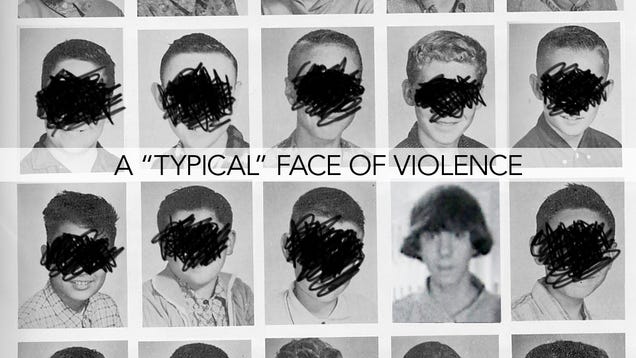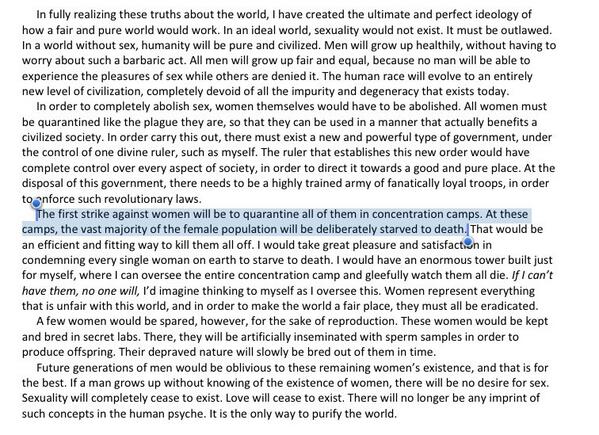The Unbearable Invisibility of White Masculinity: Innocence In the Age of White Male Mass Shootings
206,225g
41

David J. Leonard
Filed to: MASS SHOOTINGS

I have been profiled my entire life as innocent. When disruptive in class, I was told that I was eccentric, that I needed to work on my focus. Growing up, I looked for fights and conflicts yet I never fit the profile of a juvenile delinquent. The chip on my shoulder never signified a thug; I was just a kid with a bad temper who needed to mature and grow out of it.
When I was pulled over in Emeryville, CA for speeding for several miles and asked multiple times by the police officer if there was a reason for my speeding, I told him the truth. "Officer, my ice cream is melting."
No stop and frisk. No pretext stop. No humiliating search. No fear of how to hold my hands. No ticket. I, like Adam Lanza and James Holmes, the two most notorious mass shooters of the past year, am white male privilege personified. We are humanized and given voice and innocence over and over again.
***
The most recent shooting in Newtown highlights whiteness and the ways it has been rendered invisible after every mass shooting. Described as a "nerd," who "still wears a pocket protector," Adam Lanza has been reimagined as a character straight out of The Revenge of the Nerdsseries and not a cold-blood killer. He carried a brief case, not a gun; he read The Catcher in the Rye and Of Mice and Men, not Guns and Ammo; he wore button down polos, not fatigues. His life was not extraordinary but was that of an average kid. From the reading list to the sartorial choices we have been sold a Normal Rockwell painting. The Associated Press painted a picture of Adam that imaged him as a character ripped out of a Brady Bunch script: "He was an honors student who lived in a prosperous neighborhood with his mother, a well-liked woman who enjoyed hosting dice games and decorating the house for the holidays."
While identified as "reclusive," and "shy," as "quiet and reserved," as "weird" and a "loner" outcast, Lanza has been consistently described as an average kid who had problems and difficulties. At worst, he was odd and painfully shy. "He didn't have any friends, but he was a nice kid if you got to know him," said Kyle Kromberg. "He didn't fit in with the other kids. He was very, very shy." Yet, the constant quest to figure out what caused him to snap, to speculate about the effects of his parents' divorce or medications, all refashions Lanza as a good kid, a victim of sorts. He just snapped so there must have been a reason. Yes, he was strange, but do good (white, suburban, upper-middle class) kids shoot up an elementary school? Thus, reports the New York Post: "Bloodthirsty child killer Adam Lanza might have snapped, and carried out his unspeakable atrocities after learning that his mom wanted him thrown in the loony bin, according to published reports today."
The narrative following Adam Lanza and Newtown might as well recycled the media coveragesurrounding James Holmes and the Aurora, Colorado shooting. Described as "smart" and quiet, as "nice," and "easy-going," the narrative sought to not only humanize James Holmes, but also imagine him as good at his core. It worked to tell a story of a normal kid, whose life turned toward evil for some yet-to-be-explained reason.
Sympathetic and identifiable, Holmes was depicted as Beaver Cleaver for most of his life. Anthony Mai, a longtime family friend, told the Los Angeles Times: "I saw him as a normal guy, an everyday guy, doing everyday things." Like many others in the community, he is "very shy, well-mannered young man who was heavily involved in their local Presbyterian church." The AP similarly depicted Holmes as a cross between Norman Rockwell, Jason, and Opie. Mind you the extent of its evidence comes from someone who had a beer with him at a local bar. "We just talked about football. He had a backpack and geeky glasses and seemed like a real intelligent guy and I figured he was one of the college students." Can you imagine having your identity reduced to a single meeting at a bar? Sure, he was quirky, and a bit of a "loner" but he was a "reserved" and "respectful" "kid."
206,225g
41

David J. Leonard
Filed to: MASS SHOOTINGS
- TRUE STORIES
- WHITENESS
- WHITE PEOPLE
- HONKY BAIT
- ADAM LANZA
- JAMES HOLMES
- DARK KNIGHT SHOOTING
- SANDY HOOK SHOOTING
- TOP

I have been profiled my entire life as innocent. When disruptive in class, I was told that I was eccentric, that I needed to work on my focus. Growing up, I looked for fights and conflicts yet I never fit the profile of a juvenile delinquent. The chip on my shoulder never signified a thug; I was just a kid with a bad temper who needed to mature and grow out of it.
When I was pulled over in Emeryville, CA for speeding for several miles and asked multiple times by the police officer if there was a reason for my speeding, I told him the truth. "Officer, my ice cream is melting."
No stop and frisk. No pretext stop. No humiliating search. No fear of how to hold my hands. No ticket. I, like Adam Lanza and James Holmes, the two most notorious mass shooters of the past year, am white male privilege personified. We are humanized and given voice and innocence over and over again.
***
The most recent shooting in Newtown highlights whiteness and the ways it has been rendered invisible after every mass shooting. Described as a "nerd," who "still wears a pocket protector," Adam Lanza has been reimagined as a character straight out of The Revenge of the Nerdsseries and not a cold-blood killer. He carried a brief case, not a gun; he read The Catcher in the Rye and Of Mice and Men, not Guns and Ammo; he wore button down polos, not fatigues. His life was not extraordinary but was that of an average kid. From the reading list to the sartorial choices we have been sold a Normal Rockwell painting. The Associated Press painted a picture of Adam that imaged him as a character ripped out of a Brady Bunch script: "He was an honors student who lived in a prosperous neighborhood with his mother, a well-liked woman who enjoyed hosting dice games and decorating the house for the holidays."
While identified as "reclusive," and "shy," as "quiet and reserved," as "weird" and a "loner" outcast, Lanza has been consistently described as an average kid who had problems and difficulties. At worst, he was odd and painfully shy. "He didn't have any friends, but he was a nice kid if you got to know him," said Kyle Kromberg. "He didn't fit in with the other kids. He was very, very shy." Yet, the constant quest to figure out what caused him to snap, to speculate about the effects of his parents' divorce or medications, all refashions Lanza as a good kid, a victim of sorts. He just snapped so there must have been a reason. Yes, he was strange, but do good (white, suburban, upper-middle class) kids shoot up an elementary school? Thus, reports the New York Post: "Bloodthirsty child killer Adam Lanza might have snapped, and carried out his unspeakable atrocities after learning that his mom wanted him thrown in the loony bin, according to published reports today."
The narrative following Adam Lanza and Newtown might as well recycled the media coveragesurrounding James Holmes and the Aurora, Colorado shooting. Described as "smart" and quiet, as "nice," and "easy-going," the narrative sought to not only humanize James Holmes, but also imagine him as good at his core. It worked to tell a story of a normal kid, whose life turned toward evil for some yet-to-be-explained reason.
Sympathetic and identifiable, Holmes was depicted as Beaver Cleaver for most of his life. Anthony Mai, a longtime family friend, told the Los Angeles Times: "I saw him as a normal guy, an everyday guy, doing everyday things." Like many others in the community, he is "very shy, well-mannered young man who was heavily involved in their local Presbyterian church." The AP similarly depicted Holmes as a cross between Norman Rockwell, Jason, and Opie. Mind you the extent of its evidence comes from someone who had a beer with him at a local bar. "We just talked about football. He had a backpack and geeky glasses and seemed like a real intelligent guy and I figured he was one of the college students." Can you imagine having your identity reduced to a single meeting at a bar? Sure, he was quirky, and a bit of a "loner" but he was a "reserved" and "respectful" "kid."
 at Honky Bait.
at Honky Bait.










 sounds straight out of a Batman book.
sounds straight out of a Batman book.


